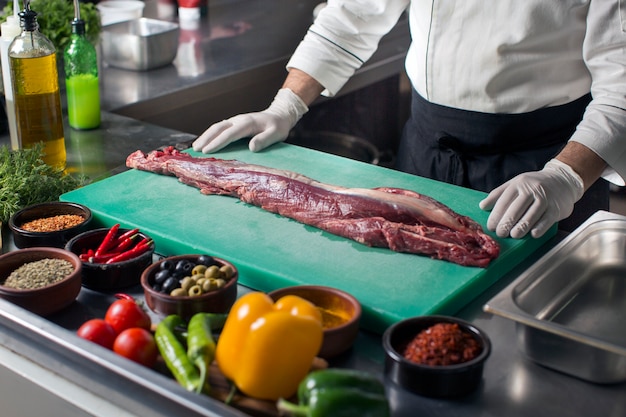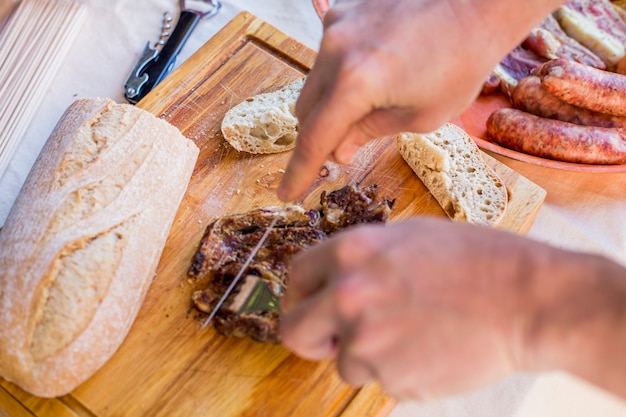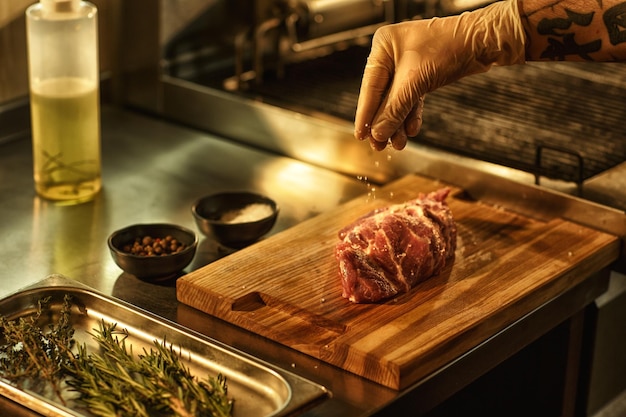Ah, prime rib. The king of roasts, a showstopper that instantly elevates any gathering to a feast. It's a dish that speaks of celebration, of indulging in something special. But let's be honest, cooking a prime rib can be a bit nerve-wracking. You want that gorgeous crust, that tender, juicy pink center, and absolutely no hint of dryness. It's a culinary tightrope walk, and you want to make sure you land gracefully. That's where I come in. I've spent years in the kitchen, tackling countless roasts, and I'm here to share my hard-earned wisdom, guiding you towards a perfectly cooked prime rib that will impress even the most discerning palate.
This guide isn't just a list of instructions. It's a journey into the heart of prime rib roasting, a conversation filled with tips, tricks, and real-life experiences that will help you feel confident and comfortable in the kitchen. Grab a comfy spot, a pen and notepad, and let's get started!
(Part 1) choosing the right cut: Your Prime Rib Foundation

First things first, you need to choose the right cut of meat. Prime rib, you see, is a cut taken from the rib section of a beef carcass, typically between the 6th and 12th ribs. It's a naturally flavorful, richly marbled cut that's perfect for roasting. You've got two main choices to consider:
1. standing rib roast: The Majestic Roast
This is the classic, the showstopper. A standing rib roast comes with the rib bones intact, giving it a stunning, elegant look. It's usually sold as a "bone-in" roast, and you'll see it proudly displayed in butchers' shops. It's ideal for large gatherings, as it can feed a crowd with ease.
2. Rolled Rib Roast: The Compact Option
The rolled rib roast is essentially a standing rib roast that's been carefully rolled and tied. This creates a more compact, uniform roast that's great for smaller families. The bone is often removed before rolling, making it easier to carve. Think of it as the "executive summary" of the prime rib world, offering a similar flavor profile but in a more manageable size.
Now, you might see "english cut" or "Standing Rib Roast" on the label. Don't let these terms confuse you. They're essentially interchangeable, though "English Cut" usually refers to a roast that includes the rib bone. The best approach is to simply ask your butcher. They'll be more than happy to clarify the different cuts and help you choose the perfect one for your needs.
Size and Weight: A Matter of Guests
Think of it this way: a general rule of thumb is to plan for roughly 1 pound of meat per person for a main course. So, for a dinner party of 6, you'll want a roast that weighs around 6 pounds. However, keep in mind that this is just a guideline. Consider any side dishes and appetizers you'll be serving. You don't want to end up with too much or too little! And, of course, your butcher is your best friend in this situation. They have the expertise to guide you towards the perfect size based on your guest count and dietary preferences.
(Part 2) Preparing Your Prime Rib: The Art of the Pre-Roast

Now, you've got your chosen cut of prime rib, and it's time to get it ready for its grand entrance into the oven. This is where you bring out your culinary artistry, setting the stage for a truly unforgettable roast.
1. Pat It Dry: A Critical First Step
Take your prime rib out of the refrigerator and let it sit at room temperature for about an hour before you start cooking. This allows the meat to come to room temperature, resulting in a more even cook. Don't rush it! Patience is key. While it's acclimating, pat the roast dry with paper towels. This step is crucial to prevent excess steaming in the oven, allowing for a beautifully crisp crust to form.
2. Seasoning is King: A Symphony of Flavor
Here's where the fun truly begins. Seasoning your prime rib is about creating a flavor profile that dances on your taste buds. You can go classic with a simple salt and pepper blend, or unleash your inner chef with a more complex spice mix. I'm a big fan of using a mixture of salt, pepper, garlic powder, onion powder, and a touch of paprika. It adds a warm, savory depth that's irresistible.
Whatever you choose, rub the seasoning generously all over the roast, making sure to get into all the nooks and crannies. Don't be shy, the more seasoning you use, the more flavourful your prime rib will be.
3. Don't Forget the Fat Cap: A Culinary Treasure
If your roast has a fat cap, that layer of fat that sits atop the meat, resist the urge to trim it all off. That fat is your best friend! It will melt during cooking, basting the meat from the inside out, and contribute to a juicy, flavorful roast. It's the secret ingredient to that melt-in-your-mouth tenderness we all crave. Just score the fat cap with a knife at 1-inch intervals, creating little channels for the fat to render evenly. This will prevent the fat from pooling and ensure a more consistent cook.
(Part 3) Roasting Your Prime Rib: A Culinary Dance in the Oven

Now, the moment we've all been waiting for – roasting! This is where the real magic happens, transforming your raw prime rib into a culinary masterpiece.
1. Preheat Your Oven: The First Step to Success
Preheat your oven to 450°F (230°C). This high temperature is key for searing the prime rib, giving it that irresistible, crispy crust that we all adore. It's like a culinary handshake, a promise of the deliciousness to come.
While your oven is heating up, place a rack in the bottom of your roasting pan. This will elevate the roast, preventing it from sitting in any juices that may drip during cooking.
2. Sear It Up: A Golden Crust to Delight
Now, place the prime rib in the roasting pan, fat cap facing up. Roast it for 15 minutes, giving it a beautiful sear on all sides and kick-starting the browning process. This high-heat sear will create a gorgeous, crispy crust, locking in those incredible flavors and adding a touch of culinary magic.
3. Lower the Heat and Roast Some More: A Slow and Steady Cook
After 15 minutes, reduce the oven temperature to 325°F (160°C). This slower cooking temperature ensures that the meat cooks evenly throughout without drying out. You'll be rewarded with a juicy, tender roast that melts in your mouth. Now, here's where your personal preference comes into play. How do you like your prime rib? Rare, medium-rare, medium, or well-done? I, for one, am a big fan of medium-rare, with that delightful pink center. Adjust your cooking times accordingly to achieve your desired level of doneness.
As a general guideline, roast for about 15 minutes per pound for a medium-rare roast. But remember, every oven is different. So, keep a close eye on the roast and use a meat thermometer to ensure it's cooked to your liking.
4. Rest It Out: The Final Touch of Perfection
Once your prime rib reaches the desired internal temperature, take it out of the oven and let it rest for 15-20 minutes before carving. This resting period allows the juices to redistribute throughout the meat, resulting in a more tender and flavorful cut. I like to cover it with foil during this time to keep it warm and prevent it from drying out. Imagine it as a little "timeout" for your prime rib, giving it a chance to relax and release those delicious juices.
5. Don't Forget the Roast Juices: The Secret Weapon of Flavor
While your prime rib is resting, don't discard those flavorful roasting juices. They're the key to a delicious pan sauce, the perfect complement to your roast. Skim off any excess fat and strain the remaining liquid. This is your base for culinary magic. Simply add a splash of red wine or beef broth, and simmer for a few minutes to reduce and thicken the sauce. It's a surprisingly simple step that elevates the whole dish, adding a layer of rich, savory depth that will have your guests begging for more. Trust me, this pan sauce is a game-changer.
(Part 4) Doneness: Deciphering the Language of Cooking
So, how do you know when your prime rib is perfectly cooked? There are two main methods you can rely on to ensure a successful roast.
1. Use a Meat Thermometer: Your Culinary Compass
This is the most accurate and reliable method for checking doneness. Insert a meat thermometer into the thickest part of the roast, avoiding the bone. Here's a handy table to guide you:
| Doneness | Internal Temperature (°F) | Internal Temperature (°C) |
|---|---|---|
| Rare | 125-130 | 52-54 |
| Medium-Rare | 130-135 | 54-57 |
| Medium | 135-140 | 57-60 |
| Medium-Well | 140-145 | 60-63 |
| Well-Done | 145-150 | 63-66 |
2. The Touch Test: A Sensory Guide (But Not as Reliable)
If you don't have a meat thermometer handy, you can use the touch test. It's not as accurate as a thermometer, but it can give you a general idea. Press the centre of the roast with your finger. If it feels firm and springy, it's likely medium-rare. If it feels firmer, it's probably medium or well-done. But remember, this method is subjective and depends on your individual touch and sensitivity.
(Part 5) Variations: Adding Your Signature Touch
You might be thinking, "Salt and pepper is nice, but can I get a bit more creative?" Absolutely! This is where you personalize your prime rib, infusing it with your unique culinary vision. There are endless possibilities when it comes to flavoring prime rib. Here are some ideas to spark your imagination:
1. Herb Rubs: Aromatic Delights
Combine fresh or dried herbs with your favorite spices, creating a custom blend that speaks to your taste buds. Think thyme, rosemary, garlic powder, and onion powder, all harmonizing together to create a symphony of flavors. You can also add a touch of citrus zest, like lemon or orange, for a bright and tangy element.
2. Mustard Glaze: A Sweet and Tangy Indulgence
A simple glaze made with Dijon mustard, brown sugar, and a touch of honey can add a delightful sweetness and tang to your prime rib. Brush it on the last 30 minutes of cooking, allowing it to caramelize and create a glistening, flavorful finish.
3. Garlic and Rosemary Infusion: A Classic Combination
Before roasting, rub the prime rib with a mixture of crushed garlic and rosemary sprigs. This will infuse the meat with a wonderful garlicky and rosemary flavour, adding a touch of rustic charm to your dish.
4. Coffee Rub: A Surprising Depth of Flavor
For a truly unique flavour experience, try a coffee rub. Combine ground coffee, brown sugar, paprika, and a touch of salt and pepper. The coffee adds a surprising depth of flavour to the prime rib, complementing the richness of the beef. You can use your favourite coffee blend for this, or go for a bolder, darker roast for a more intense flavor.
(Part 6) Carving: A Masterful Presentation
Your prime rib has rested, and it's time to showcase its culinary prowess – carving! It might seem intimidating, but with a few simple tips, you'll be carving like a pro in no time.
1. Use a Sharp Knife: The Key to Clean Cuts
A sharp knife is your secret weapon. If you have a carving knife, use it! But a good quality chef's knife will also do the trick. Make sure your knife is sharp and that you're comfortable handling it. A dull knife will only make the task more difficult, resulting in uneven cuts and frustrated sighs.
2. Cut Against the Grain: The Secret to Tenderness
This is the key to creating tender, juicy slices. The grain refers to the direction of the muscle fibres in the meat. cut across the grain, making thin slices. This will make the meat easier to chew and will enhance the overall tenderness. It's a simple technique with a big impact.
3. Remove the Bone (If Applicable): A Gentle Extraction
If you're carving a standing rib roast, you'll need to remove the bone before slicing. Carefully cut around the bone, using your knife to slide between the bone and the meat. Once the bone is removed, you can easily slice the roast into thin, delicious pieces.
4. Arrange and Serve: A Culinary Showstopper
Once you've carved your prime rib, arrange the slices beautifully on a platter. Serve with your chosen sides and the pan sauce. It's time to savour the fruits of your labor!
(Part 7) Storing Leftovers: Keeping the Deliciousness Alive
Let's be honest, there's a good chance you'll have some leftover prime rib. But don't be disheartened! Leftover prime rib is even better the next day. It's perfect for sandwiches, salads, or a delicious breakfast hash. Here's how to store it properly to keep it fresh and flavorful.
1. Refrigerate Properly: The First Line of Defense
Place the leftover prime rib in an airtight container or wrap it tightly in plastic wrap. Refrigerate it within two hours of cooking. This helps to prevent bacterial growth and ensures that your prime rib stays safe and delicious.
2. Keep it Moist: Preventing Dryness
To prevent the leftover prime rib from drying out, you can add a little bit of pan sauce or broth to the container before storing it. This will help to keep it moist and flavorful, preserving the taste and texture you worked so hard to achieve.
3. Use Within 3-4 Days: For Optimal Enjoyment
While leftover prime rib can last for up to 3-4 days in the refrigerator, it's best to use it sooner rather than later. This will ensure the best flavour and texture, allowing you to fully enjoy the deliciousness of your prime rib masterpiece.
(Part 8) FAQ: Your Prime Rib Queries Answered
Now, let's tackle some of the common questions that pop up when it comes to cooking prime rib.
1. Can I roast prime rib in a slow cooker?
While technically possible, I wouldn't recommend it. Slow cookers don't provide the high heat needed to sear the prime rib properly, which is essential for achieving that delicious crust. The result might be a bit mushy and lacking in flavour. Stick to the oven method for the best results.
2. Can I Freeze Prime Rib?
Yes, you can freeze prime rib for up to 3-4 months. Wrap it tightly in plastic wrap and then again in foil or freezer paper. To defrost, thaw it in the refrigerator for 2-3 days before roasting. It's best to defrost it in the fridge, rather than at room temperature, to prevent bacterial growth.
3. What Are Some Good Side Dishes for Prime Rib?
The beauty of prime rib is that it pairs beautifully with a variety of sides. Here are a few of my personal favourites:
- Roasted potatoes, crispy on the outside, fluffy on the inside
- Creamy mashed potatoes, the ultimate comfort food
- green beans, with a touch of butter and salt
- Asparagus, roasted or grilled to perfection
- Brussels sprouts, roasted until slightly caramelized
- Yorkshire pudding, a classic British accompaniment
- Garlic bread, a simple but delicious pairing
- Caesar salad, a refreshing and flavorful contrast
4. How Do I Know If My Prime Rib is Safe to Eat?
The internal temperature of the prime rib should reach at least 145°F (63°C) for safe consumption. Use a meat thermometer to ensure it's cooked through and safe to enjoy.
5. What If My Prime Rib Is Overcooked?
Don't despair! While overcooked prime rib will be less tender, it can still be delicious. Try using it in a stew or other dish where tenderness is less important.
And there you have it! My comprehensive guide to cooking the perfect prime rib. Remember, practice makes perfect. The more you cook prime rib, the more confident you'll become. So go forth, embrace the challenge, and enjoy the delicious rewards!
Everyone is watching

How to Cook Frozen Lobster Tails Perfectly: A Step-by-Step Guide
RecipesLobster. Just the word conjures up images of lavish meals, special occasions, and a taste of luxury. But let's...

Pigs in a Blanket Cooking Time: How Long to Bake for Perfect Results
RecipesAh, pigs in a blanket. Just the name conjures up images of those delightful little parcels of crispy pastry en...

Pork Fillet Cooking Time: How Long to Cook It Perfectly
RecipesPork fillet, or tenderloin as it's sometimes called, is a real favourite in our house. It's so versatile, and...

The Ultimate Guide to Tender, Juicy Pulled Pork
RecipesRight, let's talk pulled pork. It's one of those dishes that just screams "comfort food," doesn't it? I mean...

The Ultimate Guide to Cooking Sweet Potatoes: From Roasting to Mashing
RecipesSweet potatoes. Just the name conjures up images of warm, comforting dishes, bursts of vibrant color, and a to...
